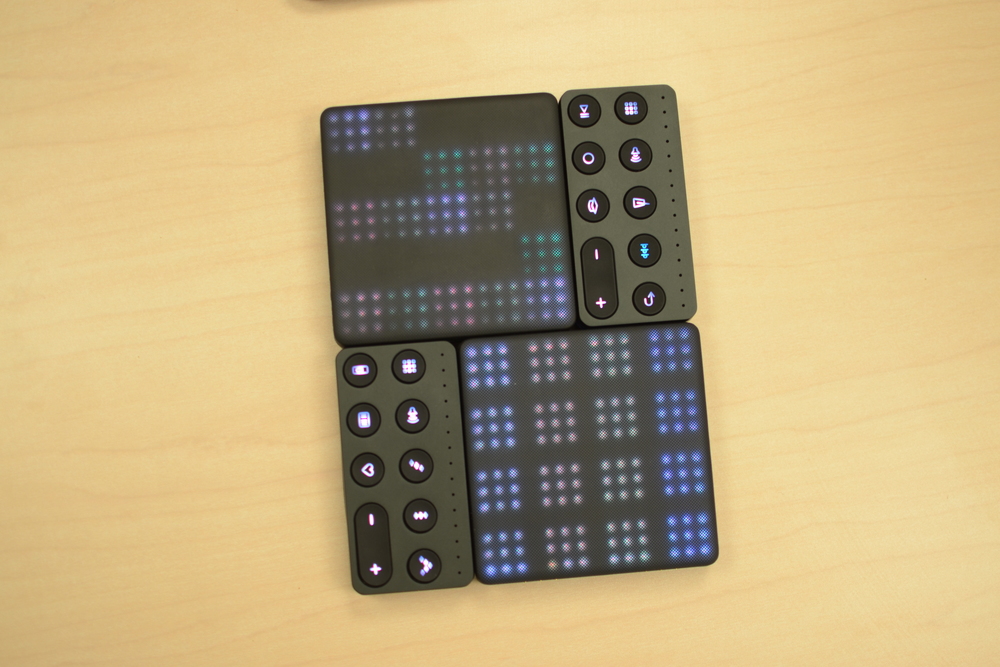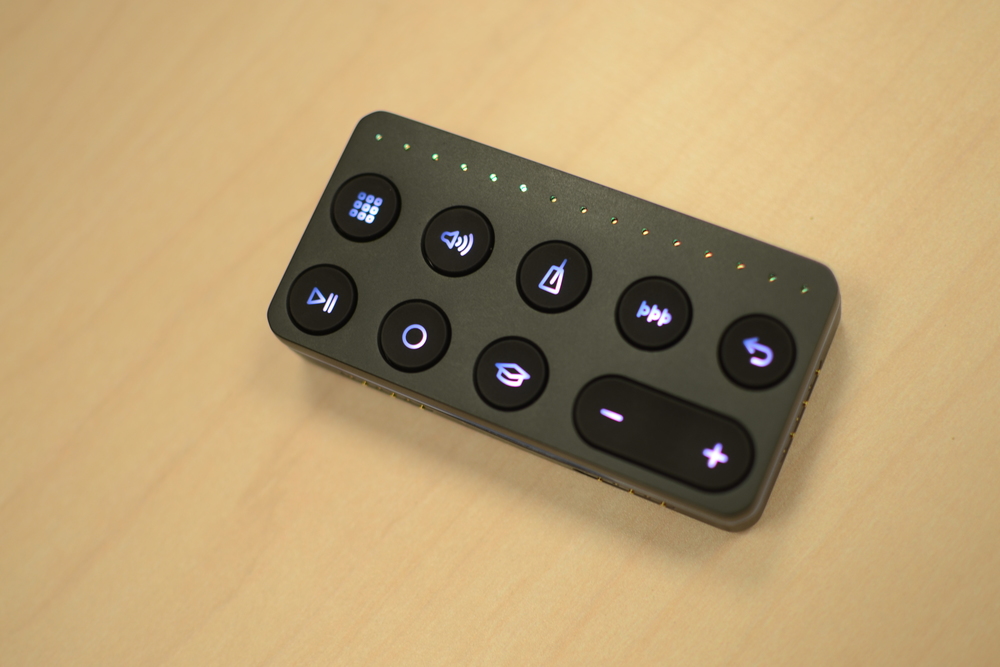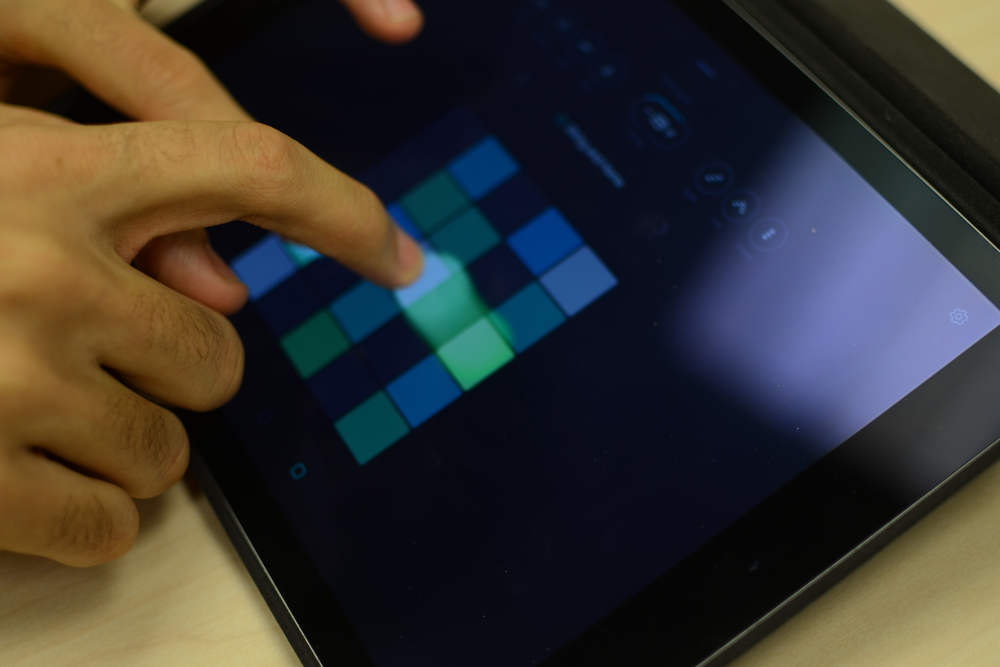British manufacturer Roli is best known for its innovative range of portable musical keyboards. The futuristic-looking Seaboard Grand, which launched last year, replaces traditional piano keys with continuous-touch “keywaves” that enable a nearly infinite number of pitches. The Noise, a virtual keyboard for iOS devices, uses phones’ “taptic” engines to approximate the tactility of physical keys. But the company’s newest musical invention is far and away its most transformative. It’s a modular series of accessories called Blocks, and it promises to be one of the most portable, intuitive, and customizable music controllers on the market.
Blocks is the product of years of collective research, said Ruben Dax, a product specialist demonstrator at Roli. “We wanted to create something powerful enough for people to shape music,” he added. “We wanted a system that could grow with you.”
Blocks may be a platform, but its undisputed flagship is the Lightpad Block, a small, black polyurethane block that’s deceptively simple in appearance. Short of a “Blocks” logo in white lettering on one of its four sides, a single USB Type-C connector, and pairs of metal contacts, it could almost pass for a spiffier model of the heating plates that inhabit college dorm rooms. Almost.
The Lightpad Block is best thought of as an instrument panel, Dax said. And in keeping with that vision, it works like an everyday, off-the-shelf MIDI controller. You assign any one of Noise’s more than 128 virtual sounds and instruments in the Noise app to individual Blocks on the Lightpad –or rows of blocks, or multiple columns, or the entirety of the controller’s light-up interface. Supplying a few of the choice’s are musicians Grimes, Steve Aoki, and RZA, who’ve partnered with Roli to produce “signature soundpacks” available from within the Noise app.
The Lightpad Block’s namesake are the dozens upon dozens of multicolored LEDs that sit millimeters beneath its perforated, touch-sensitive grid. When idle, they perform a dazzling array of animations that evoke scenes from ocean waves to whacked-out electronic dance parties. And when paired to an iPhone or iPad, they act as a physical extension of Roli’s Noise app.
It’s impressive hardware. Roli developed the Blocks platform’s magnetic connector, which transmits both power and data, entirely in-house. (The Lightpad lasts about “four hours” on a charge, Dax said.) And it optimized the Roli’s Bluetooth connectivity to perform at “zero latency”: Changes to settings within the Noise app reflect instantaneously on Blocks modules. It’s also eerily responsive: When the Lightpad is configured as an instrument controller, taps of a finger show as ghostly outlines on the Noise app’s interface.
Instrument selections are designated by color. Switch from a flute to a horn, for instance, and the Lightpad’s LEDs might shine red instead of blue, depending on your configuration. Configurations of LEDs also reflect the Noise app’s settings. Tapping a minor pentatonic scale illuminates only the blocks — notes — on that scale.
All the more impressive is the Lightpad’s versatility. Using the same pressure-sensing technology as the Seaboard Grand, the 10-finger touchpad is capable of differentiating between subtle touches, firm taps, and several degrees of force in-between. The quickness with which you release one of the glowing pads makes an audible difference in sound. Swiping your finger across lit “keys” manipulates pitch; spaces between the pads affect the timbre of the note produced. And you can mimic vibrato — the warbling sound produced by a bow moving rapidly forward and back against a stringed instrument — by wiggling your finger.
The Lightpad can do more than just control instruments. It can queue samples as part of looping sequences. You can assign those samples to individual blocks, if you so choose (pressing a colored block triggers a sample, and tapping it again pauses it). And you can pair assigned blocks with virtual instrument controls: from the Noise app’s interface, you can swap between assigned loops and instrument keys on the fly.
Additional peripherals make that manipulation easier. The optional Live Block and Loop Block, both of which require a separate purchase, attach to the Lightpad Block via a proprietary high-speed interface. They add illuminated playback controls, a metronome toggle, a dedicated “record” button, volume controls, and a multicolor progress bar that reflects the progression of the loop or song that’s playing.
When you’ve put the finishing touches on your creation, you’ll be able to share it among users of Noise.FM, Roli’s new social network for music producers. Other users can then download your creations and remix them, or collaborate and share their songs with you. And it’s entirely free, Dax said. The company is hoping Roli’s built-in Noise community — the more than 250,000 users who’ve downloaded the original Noise app — will help get the collective creative juices flowing quickly.
Blocks will also getting a lift in the form of an exclusive retail partnership with Apple. Starting later this year, the entire Blocks platform — the Lightpad Block, Live Block, and Loop Block — will go on sale at Apple Stores around the world. Employees will be trained on how to use and demonstrate the modules. The Lightpad Block will retail for $180, while the Live Bloc and Loop Block will each start at $80.
“Many areas of life have been transformed by the digital,” Roland Lamb, founder and CEO of Roli, said. “Music, though, remains a universal language that everyone understands, but only a few can speak. Blocks will change that, and enable people around the world to experience the joy of music-making for the first time.”





